Click on images to enlarge
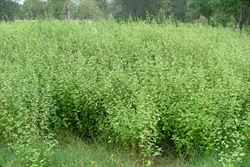
dense infestation (Photo: Sheldon Navie)

infestation (Photo: Sheldon Navie)
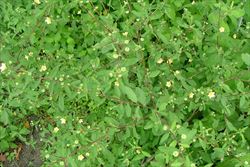
habit (Photo: Sheldon Navie)
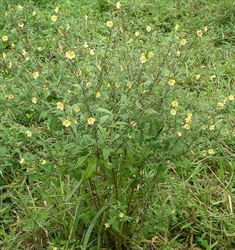
upright habit (Photo: Chris Gardiner)
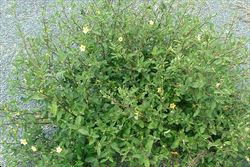
spreading habit (Photo: Sheldon Navie)
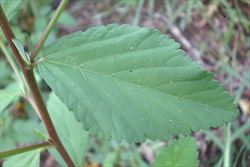
close-up of stem and diamond-shaped leaf (Photo: Sheldon Navie)
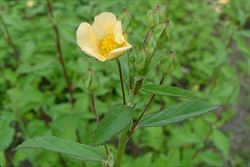
narrower upper leaves and flower buds on long stalks (Photo: Sheldon Navie)
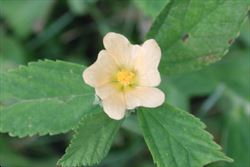
close-up of flower (Photo: Sheldon Navie)
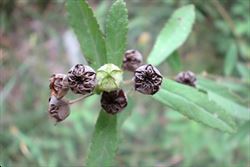
immature and mature fruit (Photo: Sheldon Navie)
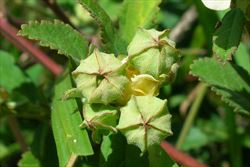
close-up of immature fruit enclosed in sparsely hairy sepals (Photo: Forest and Kim Starr, USGS)

close-up of mature fruit (Photo: Sheldon Navie)
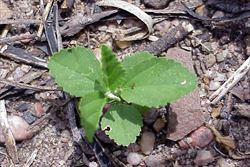
seedling (Photo: Sheldon Navie)
Scientific Name
Sida rhombifolia L.
Family
Malvaceae
Common Names
arrow leaf sida, arrow-leaf sida, arrowleaf sida, big Jack, bloom weed, broom weed, broomstick, coffee bush, common sida, country mallow Cuba jute,, Cuban jute, flaxweed, Indian hemp, jelly leaf, jellyleaf, Paddy's lucerne, Pretoria sida, Queensland hemp, rhomboid ilima, shrub sida, sida retusa, sida weed, sida-retusa, teaweed
Origin
A cosmopolitan species, particularly in warmer regions (i.e. pan-tropical), that is thought to have originated in the Americas.
Naturalised Distribution
Widely naturalised in northern and eastern Australia (i.e. Queensland, New South Wales, some parts of Victoria, many parts of the Northern Territory and the northern and south-western parts of Western Australia). Also naturalised on Lord Howe Island, Norfolk Island and Christmas Island.
Widely naturalised in other parts of the world, including New Zealand and on numerous Pacific islands (e.g. American Samoa, the Galápagos Islands, Fiji, French Polynesia, Guam, Hawaii, Kiribati, Nauru, New Caledonia, Niue Palau and the Solomon Islands).
Habitat
A common and widespread weed of disturbed sites, roadsides, pastures, grasslands, open woodlands, crops, waste areas, footpaths and gardens in tropical, sub-tropical, warmer temperate and semi-arid environments.
Habit
A long-lived (i.e. perennial) small shrub (i.e. sub-shrub) or woody herbaceous plant with upright (i.e. erect or ascending) stems. It usually grows 60-100 cm tall, but may occasionally reach up to 2 m in height.
Distinguishing Features
- a small long-lived shrub or woody herbaceous plant with upright stems usually growing up to 1 m tall.
- its stems are slender, but rather woody, with a tough stringy bark.
- its leaves are often diamond-shaped with irregularly toothed margins.
- its yellow to pale orange flowers (15-20 mm across) have five petals and are borne singly on relatively long stalks (1-4 cm long).
- its small fruit (5-6 mm across) separate into 8-12 one-seeded segments when mature.
- these wedge-shaped 'seeds' are topped with two small spines (0.5-1 mm long).
Stems and Leaves
The much-branched stems are slender, but rather woody, with a tough stringy bark. Younger stems are greenish and covered in tiny star-shaped (i.e. stellate) hairs while older stems turn brown and become almost hairless (i.e. glabrous).
The leaves are alternately arranged along the stems and are borne on stalks (i.e. petioles) 3-10 mm long. They have wedge-shaped (i.e. cuneate) bases and are usually widest about half-way along their length. These leaves (15-85 mm long and 3-40 mm wide) are often diamond-shaped (i.e. rhomboid), but may also be oblong, oval (i.e. elliptic) or lance-shaped (i.e. lanceolate), and tend to be narrower towards the tips of the upper branches. The leaves are irregularly toothed (i.e. crenate or serrate) towards their tips and are mostly entire towards their bases. They have a sparse covering of tiny star-like (i.e. stellate) hairs on their upper surfaces and a dense covering of these hairs on their lower surfaces.
Flowers and Fruit
The yellow to pale orange flowers (15-20 mm across) are produced singly in the upper leaf forks (i.e. axils). They are borne on relatively long and thin stalks (i.e. pedicels) 1-4 cm long) and have five petals (6-8 mm long). These flowers also have five sepals that are partially fused together (i.e. into a calyx tube) and are sparsely covered in tiny star-shaped hairs (i.e. stellate puberulent). Flowering occurs from spring through to autumn, and is particularly abundant during summer.
The slightly flattened or almost globular fruit (5-6 mm across and 2.5-3 mm high) turn from green to dark brown as they mature. When fully mature they separate into 8-12 one-seeded segments (i.e. mericarps). These 'seeds' (i.e. mericarps) are wedge-shaped (2-2.5 mm long) and have two vertical ribs. They are dark brown or black and topped with two small spines (0.5-1 mm long) that bear tiny backward-pointing (i.e. retrorse) barbs.
Reproduction and Dispersal
This plant reproduces by seed, which are often dispersed when their barbed awns become attached to animals, clothing and other materials. Seeds may also be spread by water, in mud, and in contaminated agricultural produce.
Environmental Impact
Common sida (Sida rhombifolia) is regarded as a significant environmental weed in the Northern Territory, where it is actively managed by community groups. It is also regarded as an environmental weed in Queensland and New South Wales, and as a minor or potential environmental weed in Victoria.
Legislation
This species is declared under legislation in the following states and territories:
- Northern Territory: B - spread to be controlled (throughout all of the Territory), and C - not to be introduced to the Territory.
- Western Australia: Prohibited - on the prohibited species list and not permitted entry into the state.
Management
For information on the management of this species see the following resources:
- the Northern Territory Department of Natural Resources, Environment and The Arts Agnote on this species, which is available online at http://www.nt.gov.au/weeds.
Similar Species
Common sida (Sida rhombifolia) can be confused with flannel weed (Sida cordifolia), spinyhead sida (Sida acuta), spiny sida (Sida spinosa), spiked sida (Sida subspicata), spiked malvastrum (Malvastrum americanum) and prickly malvastrum (Malvastrum coromandelianum). These species can be differentiated by the following differences:
- common sida (Sida rhombifolia) has oval (i.e. elliptic), lance-shaped (i.e. lanceolate) or somewhat diamond-shaped (i.e. rhomboid) leaves with a dense covering of hairs on their undersides and a sparse covering of hairs on their upper surfaces. These leaves usually have rounded tips (i.e. obtuse apices). Its flowers are borne singly on long and thin stalks (10-40 mm long) and their sepals (i.e. calyces) are sparsely hairy. The fruit usually break up into 8-12 wedge-shaped 'seeds' (i.e. mericarps) that are topped with two awns (0.5-1 mm long).
- flannel weed (Sida cordifolia) has broad or heart-shaped (i.e. cordate) leaves that are densely covered in small whitish coloured hairs (on both surfaces) that give them a felty texture. These leaves usually have rounded tips (i.e. obtuse apices) or taper to a blunt point. Its flowers are borne in small, dense, clusters on short stalks (2-4 mm long) and their sepals (i.e. calyces) are densely hairy. The fruit break up into 8-10 wedge-shaped 'seeds' (i.e. mericaprs) that are topped with two long slender awns (2.5-3.5 mm long).
- spinyhead sida (Sida acuta) has elongated (i.e. lanceolate) leaves that are hairless or sparsely hairy on both surfaces and have pointed tips (i.e. acute apices). Its flowers are borne singly or in small clusters on short stalks (2-8 mm long) and their sepals (i.e. calyces) are mostly hairless. The fruit break up into 5-8 wedge-shaped 'seeds' (i.e. mericarps) that are topped with two sharp awns (0.5-1.5 mm long).
- spiny sida (Sida spinosa) has elongated (i.e. lanceolate) to relatively broad (i.e. ovate) leaves that are sparsely hairy above and densely hairy on their undersides with blunt or pointed tips (i.e. acute apices). Its flowers are borne singly or in small clusters on relatively short stalks (3-15 mm long) and their sepals (i.e. calyces) are finely hairy. The fruit usually break up into 5 wedge-shaped 'seeds' (i.e. mericarps) that are topped with two sharp awns (about 1 mm long).
- spiked sida (Sida subspicata) has relatively narrow (i.e. lanceolate) to broad (i.e. ovate or oblong) leaves with a dense covering of hairs on both surfaces (but more so underneath). These leaves have pointed or rounded tips (i.e. acute or obtuse apices). Its flowers are almost stalkless and borne in elongated clusters (i.e. spikes) with a few small leaves sometimes interspersed between them. Their sepals (i.e. calyces) are finely hairy and the fruit break up into 4-6 wedge-shaped 'seeds' (i.e. mericarps) that have rounded tips.
- spiked malvastrum (Malvastrum americanum) has relatively narrow or broad (i.e. elliptic or ovate) leaves with a relatively dense covering of hairs on their lower surfaces and blunt or pointed tips (i.e. obtuse or acute apices). Its flowers are borne in short, dense, clusters (i.e. spikes) that are subtended by leafy bracts and their sepals (i.e. calyces) are hairy. The fruit usually break up into 8-12 wedge-shaped 'seeds' (i.e. mericarps) that have rounded tips.
- prickly malvastrum (Malvastrum coromandelianum) has broad (i.e. elliptic or ovate) leaves with a corrugated appearance and only a sparse covering of hairs. These leaves have blunt or pointed tips (i.e. obtuse or acute apices). Its flowers are borne singly on short stalks (2-5 mm long) and their sepals (i.e. calyces) are hairy. The fruit break up into 8-14 wedge-shaped 'seeds' (i.e. mericarps) that are topped with three sharp awns (0.5-1 mm long).

